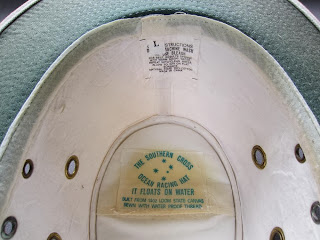For my western hat, I decided to use a gray denim I had on hand. It is heavy and supple, like a pair of comfortable jeans. It made a great slouchy bucket hat, as you can see:
I had used a medium-weight fusible interfacing on both brim pieces. That and the concentric lines of stitching gave this brim just the right stiffness. There is no stiffener in the crown. The western-style hat, though, has to be much stiffer, especially the brim.
I looked through the fabric stiffeners I had on hand. I really wanted some buckram, which is like a very, very stiff cheescloth. It's the right thing to use in hats and costumes. But I didn't have any. The only product I had on hand that I thought might work was some stuff that bonds one fabric to another. I decided to give it a try.
The photo above is staged to show how the crown piece fits so neatly inside the brim piece. I actually cut two oval pieces of the denim that were a little larger than the brim pattern, fused those together using the product (think grilled-cheese sandwich), then cut around the outer edge of the brim.
I decided not to reinforce the side piece at this time because I knew that would make sewing the crown seam very difficult. Denim has the ability to be molded a bit, and I wanted the seam at the top of the hat to be very smooth and the side piece to sort of roll over the edge of the crown, as it does in the original hat. The original hat was probably steam-formed after it was constructed. I had to achieve the same look by manipulation of the fabric weave, easing a slightly longer side piece onto the crown piece, and paying attention to the grainline. Bottom line: fused fabric has no ease whatsoever. It is like sewing with a sheet of plastic. So I decided that I would insert the side stiffener between the crown and its lining later, after both sections were constructed, rather than fusing it to either beforehand.
By the way, notice the grainline arrow on the side pattern piece? Disregard it. That piece is cut so that the center front is on the straight-of-grain, and the only seam is at the center back. If you don't follow, don't sweat it. I just didn't want you to make any inference from that arrow, if you were going to, which was an idea I abandoned later for multiple reasons that I'm sure you don't really want to hear about.
Above is the result. As you can see, the flex is about right for a floppy hat. Not right for a western hat. I was going to abandon this piece, but managed to use it after all, as you'll see later.
Note that I sewed the concentric stitching lines and bound the outer edge of the brim now rather than later. In fact, I did this before I cut out the center. It just made sense to do these things before the project became 3-dimensional.
 |
| Later version of the same brim with additional stiffener |
The photo above shows the brim after I fixed it. I went to Walmart, bought a piece of very stiff interfacing, fused it to a new piece of denim, cut another brim layer from this, then unstitched the bound edge on the droopy brim, laid the new piece on top of it, secured it all together with another session of concentric stitching, and reattached the binding.
This is the kind of thing people do when they're obsessed, no? I'd never do it otherwise. But there is a very great advantage in this kind of striving. It is enormously instructive! I never mind throwing out a project and starting over, even if I've put a great deal of work into it. Some pieces are destined to be just for learning. At this point, I don't know if this hat will be one of them. It's always exciting to be able to solve problems and "stay in the saddle" as long as possible. If I manage to complete a project, that's really great, but the journey is why I do it. Truly.
I'll talk about the crown in the next post.



























